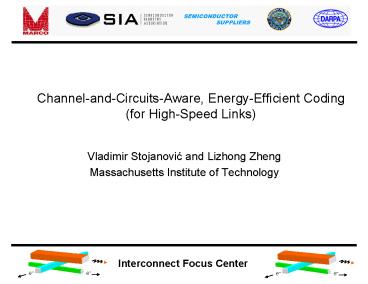ChannelandCircuitsAware, EnergyEfficient Coding for HighSpeed Links - PowerPoint PPT Presentation
1 / 12
Title:
ChannelandCircuitsAware, EnergyEfficient Coding for HighSpeed Links
Description:
Analysis of FEC and Trellis codes (implementation cost vs. BER) Experimental setup ... Theoretical analysis of Trellis and FEC codes ... – PowerPoint PPT presentation
Number of Views:61
Avg rating:3.0/5.0
Title: ChannelandCircuitsAware, EnergyEfficient Coding for HighSpeed Links
1
Channel-and-Circuits-Aware, Energy-Efficient
Coding (for High-Speed Links)
- Vladimir Stojanovic and Lizhong Zheng
- Massachusetts Institute of Technology
2
Driver 1 Electrical I/O Challenges
- 40Tb/s I/O
- With 10Gb/s per link
- 4000 transceivers
- 8000 high-speed I/O pairs
- 4000 mm2 in 0.13 µm technology
- Power 1.6kW
- 40mW/Gb/s
3
Driver 1 8000 diff pairs - Density issues
- Connectors
- 50 diff pairs/inch
- 160 long connector
- Trace routing
- 50mils pitch
- 100 wide 4-signal layer line-card
- Backplane less critical
- Package
- Package/Chip ball pitch (1mm / 200um)
- 1600 mm2 / 64mm2
4
Driver 1 Needs
- Power
- Reduce energy/bit to 2mW/Gb/s
- Density
- Increase data rate per link by 10x
5
How efficient are high-speed links?
Component cost
Scaling with data rate
- 2-3 orders more energy-efficient
- Than traditional wireline systems
- But, starting to pay the price for band-limited
channels
6
Link channels and data rates
- Capacity very high 80-100 Gb/s
- Even in legacy backplanes
- Uncoded multi-tone data rates 40-50Gb/s
- Very low BER requirements (10-15)
- Peak transmitter power constraint
7
Opportunity for coding
- Break the coding/equalization/modulation
hierarchy - Goal to minimize overall energy cost per bit
- Coding is more energy-efficient in achieving the
low BER than modulation/equalization - Especially with lots of crosstalk and numerous
small reflections - Need new paradigms in code development to
specification - Non-Gaussian (system) noise
- Circuit non-idealities
- Crosstalk and residual channel memory (ISI)
8
Project plan
- Phase 1 Link Simulation
- Stochastic Link BER estimation with coding,
channel and noise memory - Phase 2 Power-Performance analysis
- Analysis of FEC and Trellis codes (implementation
cost vs. BER) - Experimental setup
- Phase 3 Design of new, energy-efficient codes
- Propagate channel and circuit non-idealities to
the code design level - Phase 4 Implementation of new codes
- Algorithms for efficient VLSI implementation of
new codes - Experimental verification
9
Phase 1 Link Simulation (under way)
- Coded data, ISI, crosstalk and jitter all have
long memory - Huge state-space for Monte-Carlo simulation
- Nearly impossible to simulate for BER targets of
10-15 - Use Importance Sampling methods to get faster
simulations - Change the input distributions to enhance more
error events - Compensate in the end for the distorted input
distributions - Need to be careful in picking the input
distributions - Conditioning and Large Deviation Theory can help
with that
10
Phase 2 Performance characterization (under way)
- Experimental setup
- Xilinx fabric
- Coder/Encoder
- 3-10Gb/s Rocket I/O links
- Backplanes and line-cards (Rambus gift)
- 20 traces, HSD connectors
- Roger, FR4, Nelco4000 dielectric
- Counter-bored vs. not
- Theoretical analysis of Trellis and FEC codes
- Correlation of the link simulator to the
experiment
11
Simple example
- Error detection
- Simpler, potentially more energy-efficient than
error correction - CRC, extended Golay, Hamming and BCH codes very
efficient in error detection - Coder/decoders embedded easily in the serializer
and deserializer shift registers - BER targets VERY low (10-15)
- Reasonably reliable back-channels already in use
BERlt10-6 (for adaptation and link configuration) - Use error detection and retransmission (ARQ)
- Raw channel BER 10-6, packet length 20
- Max 3 retransmissions per error to match overall
BER target of 10-15 - BW overhead due to retransmission 0.002
12
Conclusion
- Lots of opportunity for coding in links
- Problem formulation different in so many ways
- Bounded, non-Gaussian noise distributions
- Residual channel memory
- Circuit non-idealities
- Energy cost offsets code performance
- Working on fast simulation methods
- Challenging stochastic/system modeling problem
- Experimental testbed and energy estimation
- Generalization
- Introducing energy-efficiency and build-to-spec
in code design































